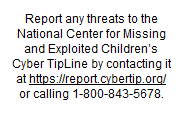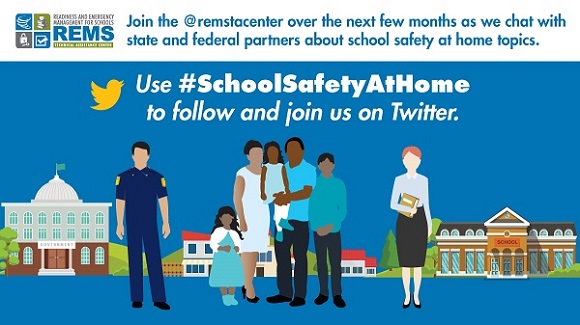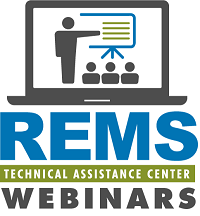|
News & Updates From the REMS TA Center, Spring 2020
The U.S. Department of Education (ED), Office of Safe and Supportive Schools and its REMS TA Center would like to express gratitude to education agency leaders, essential staff, community partners, and other key stakeholders who have stepped up this spring in response to the coronavirus disease 2019 (COVID-19) pandemic. From your efforts to redesign protocols to ensure the safety of essential staff to the extensive work done to ensure continuity of teaching, learning, feeding, and food distribution, we applaud and appreciate you. If you need technical assistance support at this time, please do not hesitate to contact us at info@remstacenter.org or via phone at 1-855-781-REMS [7367]. We also encourage you to visit our COVID-19 Web page to access newly released resources developed by the REMS TA Center and other Federal and national partners to support response and recovery efforts.

|
|
Topical Resource Feature
This section of our newsletter features resources relevant to seasonal trends, current events, and other timely topics in the field.
Accessing Funds via the Coronavirus Aid, Relief, and Economic Security (CARES) Act
Last month, U.S. Secretary of Education Betsy DeVos announced the creation of an Elementary and Secondary School Education Relief Fund (ESSER Fund) through the CARES Act to support continuity of teaching and learning for K-12 education agencies disrupted by COVID-19. ESSER funding is available specifically to state education agencies (SEAs) and local education agencies (LEAs), and leaders will be allowed flexible use of funding to support their immediate and longer-term needs. As described on the ED site, this includes “tools and resources for distance education, ensuring student health and safety, and developing and implementing plans for the next school year.”
ED has created some ESSER Fund requirements around allocations, as detailed below:
- SEAs must allocate 90 percent of funds to LEAs, including public charter schools, in proportion to the amount of fiscal year 2019 funds the LEA received under Title I, Part A of the Elementary and Secondary Education Act.
- Up to 10 percent of the SEA’s award may be retained for the state agency to use to address needs related to responding to coronavirus.
- After 1 year, SEAs must return any funds that have not been awarded, and the Secretary will reallocate those funds to the states.
 Curious about your state’s allocation for the ESSER Fund? Download, view, and share this ESSER Fund overview document created by ED. Curious about your state’s allocation for the ESSER Fund? Download, view, and share this ESSER Fund overview document created by ED.
Get current information, links, tools, and resources from ED, Federal partners, and state and local practitioners to support your COVID-19 response efforts via the REMS TA Center’s COVID-19 Web page. You can also access model strategies and practices put forth by state and local partners.
|
|
Functional Resource Feature
This section of our newsletter features resources that can support education agencies and their community partners with efforts to strengthen emergency management functions and overall preparedness capacity.
Strengthening Continuity of Operations Planning (COOP) in the Face of COVID-19
We applaud education agencies across the country as they have activated and implemented COOP plans to ensure teaching and learning, as well as the continuation of other essential services. For schools, COOP planning means preparing to support the whole school community in the event of short- and long-term student and staff absences, school dismissals, and/or school closures. The COOP plan — contained in what is known as an “annex” within a school emergency operations plan (EOP) — will describe how a school or district will work to provide for the continuation of essential services during prolonged absences caused by emergencies (e.g., an infectious disease outbreak, natural disaster, or power outage)
As outlined in the Guide for Developing High-Quality School Emergency Operations Plans, the COOP Annex aligns and is integrated with the EOP, as it
 Since schools are a subset of the community and because school systems often play key roles in community preparedness plans, especially response and recovery initiatives, effective COOP planning for schools is done in collaboration with community partners. As a part of COVID-19 planning, it is recommended that school planning teams create or update their COOP Annexes. Find a few action items below:
Since schools are a subset of the community and because school systems often play key roles in community preparedness plans, especially response and recovery initiatives, effective COOP planning for schools is done in collaboration with community partners. As a part of COVID-19 planning, it is recommended that school planning teams create or update their COOP Annexes. Find a few action items below:
- Recognize the importance of planning for continuity of teaching and learning in the face of planned and unplanned disruptions and begin planning now.
- Integrate continuity of teaching and learning into your EOP’s COOP Annex.
- Plan for continuing education strategies for students, taking into consideration varying grade levels, age levels, skill levels, and access and functional needs.
- onsider incorporating varying tools, technologies, formats, and approaches to distance learning.
Learn more about this topic via our related Ensuring Continuity of Operations and Learning During and After Emergency Incidents Web page.
|
|
Help Desk Request Snapshot
This section of our newsletter highlights a noteworthy topic among technical assistance inquiries received from the field during the last quarter.
COVID-19 Response, Digital Learning, and Cybersecurity
The onset of COVID-19 has dramatically increased the usage of digital learning formats by education agencies across the nation. As students also increasingly use the Internet and video platforms, they may become exposed to new threats. Such threats may include data breaches, cyberbullying, inappropriate content, sextortion/ransomware, oversharing, and online predation. Phishing emails, text messages, and scams with COVID-19 themes are also currently trending. Now more than ever, it is critical that schools and communities take steps to protect the well-being of youth in collaboration with caregivers and families, who are serving as key safety partners at this time.
 Cybersecurity and cyber safety are shared responsibilities of students, parents, and school personnel, especially as more students across the country are learning in the “school at home” setting. Cyber threats can impact either the human (students, teachers, and staff) or the physical or virtual (e.g., information technology [IT] networks and systems) elements of schools and school districts. While there may be some overlap in addressing human versus physical/virtual threats, preparing for each type can require input from different individuals with experience or expertise on that topic and unique actions before, during, and after an incident. Schools may therefore choose to plan for these threats separately, but still under a broader umbrella of cyber threats. Cybersecurity and cyber safety are shared responsibilities of students, parents, and school personnel, especially as more students across the country are learning in the “school at home” setting. Cyber threats can impact either the human (students, teachers, and staff) or the physical or virtual (e.g., information technology [IT] networks and systems) elements of schools and school districts. While there may be some overlap in addressing human versus physical/virtual threats, preparing for each type can require input from different individuals with experience or expertise on that topic and unique actions before, during, and after an incident. Schools may therefore choose to plan for these threats separately, but still under a broader umbrella of cyber threats.
 When discussing the topic of protecting student privacy in the school at home setting, it is important to understand the variety of cyber threat types that can weaken school and school district networks and systems, including data breaches, spoofing/phishing, malware/scareware, unpatched or outdated software vulnerabilities, and use of removable media. (Access a list of common threat types here.) Schools and school districts can take a variety of actions to prevent, protect from, mitigate the effects of, respond to, and recover from cyber threats they may face and that may threaten student privacy. These can be conducted before, during, and after an incident. Find a sample list of recommendations below but note that it is not all-inclusive:
When discussing the topic of protecting student privacy in the school at home setting, it is important to understand the variety of cyber threat types that can weaken school and school district networks and systems, including data breaches, spoofing/phishing, malware/scareware, unpatched or outdated software vulnerabilities, and use of removable media. (Access a list of common threat types here.) Schools and school districts can take a variety of actions to prevent, protect from, mitigate the effects of, respond to, and recover from cyber threats they may face and that may threaten student privacy. These can be conducted before, during, and after an incident. Find a sample list of recommendations below but note that it is not all-inclusive:
- Work with your IT department to track current cybersecurity trends so that you can provide up-to-date guidelines to educators on the use of video learning platforms.
- Provide cybersecurity and cyber safety education and training to school staff, teachers, students, and families.
- Integrate cyber safety into your EOP’s Cyber Annex.
- Use filtering and blocking software to prevent students from accessing inappropriate content and sites that aim to steal their personally identifiable information.
- Create a responsible use policy that outlines expectations for students.
- Incorporate cybersecurity and digital citizenship curriculum into lesson plans.
- Encourage students to report online threats to a teacher, a school counselor, or another trusted adult.
Learn more about this topic via our Addressing Adversarial- and Human-Caused Threats that May Impact Students, Staff, and Visitors Web page.
|
|
Virtual Networking Corner
This section of our newsletter features highlights from our interactions with the field via Twitter, the Community of Practice, and other virtual events and networking platforms.
Upcoming Web Chats
To raise awareness and promote the application of emergency preparedness principles in the school at home setting, we launched a Twitter initiative in May to support members of the whole school community, including education agencies, students, families, and caregivers, with both safety and distance education at home. Through this series, we will work in collaboration with our state and Federal partners to do the following:
-
Conduct special engagement chats with partners on select topics specific to school and higher ed emergency preparedness.
- Stay tuned to receive special announcements with details on those chat dates and special guests.
-
Highlight school safety at home topics and showcase teaching and learning at home materials using the following daily schedule:
- Monday: Biological Hazards
- Tuesday: Adversarial- and Human-Caused Threats
- Wednesday: Technological Hazards
- Thursday: Natural Hazards
- Friday: #COOPTeachandLearn Resources
-
Outline the importance of and provide recommendations for ensuring school and higher ed preparedness across the community year-round.
Follow @remstacenter to get the latest updates on this Twitter chat series, and also follow the #SchoolSafetyAtHome and #COOPTeachandLearn hashtags.

Archived Webinars and Web Chats
 The REMS TA Center has hosted a variety of Webinars that might provide value right now as you alter EOPs in response to COVID-19. In 2019, we updated our Webinars page to include a search feature that allows site visitors to browse our Webinar offerings based on topic, audience, and date. Like other emergency events, pandemics such as COVID-19 require activation of various annexes within an EOP and consideration of a plethora of key emergency management planning principles. We encourage you to explore our Webinar archives to view previous topics that may be of support right now as you create and adjust EOPs and annexes in response to COVID-19. Curious about which topics to search? Try “trauma-informed care,” “displaced students,” “food safety,” “study abroad,” “COOP planning,” and “cybersecurity.” The REMS TA Center has hosted a variety of Webinars that might provide value right now as you alter EOPs in response to COVID-19. In 2019, we updated our Webinars page to include a search feature that allows site visitors to browse our Webinar offerings based on topic, audience, and date. Like other emergency events, pandemics such as COVID-19 require activation of various annexes within an EOP and consideration of a plethora of key emergency management planning principles. We encourage you to explore our Webinar archives to view previous topics that may be of support right now as you create and adjust EOPs and annexes in response to COVID-19. Curious about which topics to search? Try “trauma-informed care,” “displaced students,” “food safety,” “study abroad,” “COOP planning,” and “cybersecurity.”
Top @remstacenter Tweets for the Quarter
Secretary of @usedgov Betsy DeVos authorizes new funding flexibilities to support continued learning during COVID-19 National Emergency. #DistanceLearning
💻https://www.ed.gov/news/press-releases/secretary-education-betsy-devos-authorizes-new-funding-flexibilities-support-continued-learning-during-covid-19-national-emergency …
💛🍎💙🍎💚 Yes! Respect, gratitude and appreciation to all school systems and their communities for all they have done to protect & support students in their personal, social, physical & academic growth under these challenging circumstances. Hats off to you! https://twitter.com/CADeptEd/status/1241049416393314304 …
|


